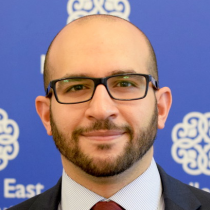Contents:
- A tectonic shift in the Middle East
- A heavy blow for Hezbollah and the Axis of Resistance
- Israeli operation against Hezbollah not limited to Lebanon
- Post-Nasrallah, how resistant is the Axis of Resistance?
- Iran vows revenge but proceeds with caution
- Shift US strategy in the Middle East from a reactive to proactive posture
- Gulf States navigate Lebanon’s crisis amid uncertainty over Hezbollah’s future
A tectonic shift in the Middle East
Paul Salem
Vice President for International Engagement

-
Israel’s killing of Hezbollah leader Hassan Nasrallah and the rapid degradation of the group’s power shows Hezbollah can no longer deter or defend against Israeli attacks, although it could still put up a fight against a land incursion.
-
In profound ways, the current rout of Hezbollah leaves Iran profoundly vulnerable: without a strategic deterrent force on Israel’s border and unable to fully prevent Israel from attacking its nuclear facilities if it attempts to quickly acquire a nuclear weapon to compensate.
The killing of Hezbollah Secretary-General Hassan Nasrallah along with the rapid degradation of Hezbollah’s power over the past two weeks signals a tectonic shift in the Middle East.
Hezbollah can no longer deter Israel; it has no defensive capacity to defend against Israeli attacks, although it could still put up a fight against a land incursion. It also has not displayed an offensive capability on any scale that would compare to or dissuade Israel: either because Israel’s intelligence and air-defense shield have minimized Hezbollah’s offensive missile and drone capacity or because the latter is too afraid to hit Israel hard and then suffer the consequences. Another possibility is that Iran doesn’t want the group to expend its full arsenal in order to keep the powder dry for Iranian needs in case the Islamic Republic comes under direct attack.
For Iran, Hezbollah was the primary and, in many ways, the sole deterrent against Israel and its principal backer, the United States. Other Iranian militia allies or proxies in Gaza, Yemen, Syria, and Iraq could play supporting roles, but none were set up to be the strategically armed aircraft carrier parked on the Israeli border. Iran itself, with far inferior conventional capabilities than Israel or the US, and at a long distance from Israel, has limited deterrent or defensive capabilities against potential Israeli strikes.
The current rout of Hezbollah leaves Iran profoundly vulnerable. Much will depend on what Iran and Israel do next. For the Iranians, their primary and narrow option is to try to find a way to deescalate, slow or stop the Israeli onslaught, and effectively buy years of time — to review and revise their overall strategy, and to rebuild Hezbollah’s leadership and capacities. The other option would be to build a more powerful deterrent, which would be a nuclear weapon; but it might be too late for that. If Iran tries now to make a run for it, Israel — with backing from the US — will undertake airstrikes on as many Iranian security facilities, nuclear and otherwise, as it can manage. And the domestic blowback to the regime could be significant.
Of course, much will depend on what Israel — in effect, Prime Minister Benjamin Netanyahu — decides to do next. In Lebanon, the Israeli air campaign seems set to continue until the air force runs out of Hezbollah targets, no matter the cost in human lives, ruined civilian infrastructure, or the number of displaced. Israel also seems poised to undertake a land invasion, probably to reoccupy a strip of southern Lebanon roughly up to the Litani River. Whether this invasion would be a temporary in-and-out operation or a long-term military presence is not yet clear. The latter scenario would be welcomed by Hezbollah and Iran, as it would allow them to once again claim they are fighting to liberate Lebanese territory from Israeli occupation.
Whether Netanyahu will keep rushing from war to war — Gaza, then Lebanon, then Iran — or whether he will await the outcome of the US elections and consider his options vis-à-vis the Islamic Republic in 2025 is yet to be seen. But clearly the board has been cleared for a direct Israeli-Iranian reckoning of sorts.
Although the US and international mediation efforts have proven largely ineffectual in the past year, an important diplomatic opportunity exists. In its moment of deep vulnerability, it is time to be clear to Tehran that if it gives up its nuclear weapons program and network of proxy militias and agrees abide by international law, it has a secure and prosperous place in the regional as well as the global order. It’s a long shot, but much of the Iranian public would respond positively to such a shift if there were a leader in Tehran bold enough to make it.
Interestingly, a similar offer can be made to Israel. At its moment of military ascendance and triumphalism, does Israel want to invest its current ascendancy in many more decades of occupation, with all the resistance, revenge and recurring war that that will engender? Or is it willing to seize the historic moment, accept the outstretched hand from the Arab and Muslim worlds, and help bring about a final and sustainable two-state resolution to the Israeli-Palestinian crisis that is embedded in a friendly Middle East and global order?
This is an excerpt from a longer version of this article, which was published here.
Follow: @paul_salem
A heavy blow for Hezbollah and the Axis of Resistance
Randa Slim
Senior Fellow and Director of Conflict Resolution and Track II Dialogues Program

-
Sayyed Hassan Nasrallah’s assassination has dealt Hezbollah a heavy blow from which it will take time to recover and called into question its ability to protect its own commanders, let alone defend Shi’a-majority areas.
-
Hezbollah served as the Iranian proxy network’s anchor and stabilizer, and the dramatic and sudden upending of its internal stability will impact that of the broader Axis of Resistance.
In his 32 years as Hezbollah’s secretary-general, Sayyed Hassan Nasrallah shaped the organization into a political and military force to be reckoned with, both domestically and regionally. His assassination has dealt Hezbollah a heavy blow that will take time to recover from. Neither of his potential successors, Deputy Secretary-General Naim Qassem or Executive Council Chairman (and Nasrallah’s cousin) Hashem Safieddine, possesses his leadership and oratory skills or commands the loyalty of the group’s rank and file and supporters like Nasrallah did.
Nasrallah was Hezbollah’s communicator-in-chief. When Hezbollah and Iran decided to intervene militarily in Syria to save the regime of Bashar al-Assad in opposition to the prevailing attitudes among Lebanon’s Shi’a at the time, Nasrallah was the one who shaped Hezbollah’s public narrative to overcome such opposition.
Nasrallah’s demise comes at a time when two of the organization’s principal tenets have been shaken to the core. Deep and successful infiltration by Israeli intelligence has undermined the trust that bound the group together. Hezbollah’s inability to protect its own commanders, let alone defend against and deter Israeli aggression against Shi’a-majority areas, has called into question a central belief among the group’s supporters that Hezbollah — and Nasrallah in particular — is their protector. As Nasrallah has argued in many of his speeches over the years, the primary purpose of Hezbollah’s weapons was to protect Lebanon’s Shi’a from external and domestic aggressors.
Under Nasrallah’s leadership, Hezbollah became Iran’s most trusted Arab partner. Looking at Iran’s regional proxy network as a franchise, Hezbollah was the first franchisee and the model on which those that followed in Iraq, Yemen, and Syria were based. Hezbollah trained the other proxy groups and served as the network’s anchor and stabilizer. The dramatic and sudden upending of its internal stability will impact that of the broader Axis of Resistance.
No other Arab leader in Iran’s regional proxy network commands as much respect and has the experience to play the role Nasrallah did. In 2020, after Iraqi Kata’ib Hezbollah leader Abu Mahdi al-Muhandis was assassinated, along with Islamic Revolutionary Guard Corps (IRGC) Quds Force Commander Qassem Soleiman, Nasrallah stepped in to provide leadership and direction for the pro-Iran Iraqi militia network. In Yemen, the Houthi leadership’s relationship with Iran was mediated by Hezbollah and by Nasrallah in particular. I will never forget the reverence with which Houthi leader Mahdi al-Mashat spoke about Nasrallah in discussions I had with him in 2015-16. The alliance between Hezbollah and the Syrian regime was underpinned by a personal relationship between Assad and Nasrallah established before the year 2000, when the former became Syria’s president.
Nasrallah’s demise creates a challenge for the IRGC Quds Force in keeping its Arab partners and proxies in line. Going forward, the Quds Force will need to be more directly involved not only in Hezbollah’s inner workings, including the reorganization of its leadership structure, but also in regulating, controlling, and coordinating the proxy network’s activities.
Where does Hezbollah go from here? It needs to face three challenges: first, appoint and rally behind a successor to Nasrallah and reassure its fighters and supporters that chaos will not ensue in its ranks; second, reorganize its ranks, especially its military command structure, which has been decimated by Israeli assassinations; and third, counter its deep infiltration by Israeli intelligence.
On the military front, the immediate question Hezbollah must address is whether it will continue the war of support for Hamas and Gaza that it launched on Oct. 8. In his speech today, Naim Qassem said it will do so. It is hard to imagine, given the successive heavy blows Hezbollah has been dealt, that the group’s immediate priority is not to get its house in order first.
Consequently, there is a short window of opportunity for the United States, France, and regional countries led by Saudi Arabia to step in and lead a two-track initiative, focusing on 1) mediating a cease-fire between Israel and Lebanon and implementing United Nations Security Council Resolution 1701 in full, and 2) getting the Lebanese parliament speaker, Nabih Berri, to convene a special session of parliament to elect a consensus president. This initiative should also include a substantial aid package that is conditional on the Lebanese cabinet enacting the structural economic and financial reforms put forward by the International Monetary Fund. This would require a heavy diplomatic lift by a US administration that is nearing the end of its term.
If Israel were to decide to move forward with a ground invasion and eventually a reoccupation of parts of southern Lebanon, Hezbollah’s new leadership will be in a strong position to rally its troops, supporters, and Lebanese society writ large behind the fight to liberate the south. Were that to happen, any chance of weakening Hezbollah’s stranglehold on Lebanese politics and enacting reforms would be lost.
Follow: @rmslim
Israeli operation against Hezbollah not limited to Lebanon
Charles Lister
Senior Fellow, Director of Syria and Countering Terrorism & Extremism programs

-
The Israeli military and intelligence apparatus have conducted the most efficient “decapitation” campaign in counterterrorism history, methodically neutralizing countless Hezbollah individuals long thought untouchable or unreachable.
-
Nevertheless, despite the extraordinary defeats imposed upon Hezbollah, hostilities may yet be far from over; Israeli strikes are also targeting Hezbollah and associated targets on Syrian soil, with multiple sites hit in Quneitra, Rif Dimashq, and Daraa in recent days, and creating a surge in attacks between Iranian proxies and locally operating US forces.
There truly can be no overstating the significance of Hassan Nasrallah’s death, along with those of dozens of other Hezbollah leaders and military commanders over the past two weeks of Israeli strikes in Lebanon. Simply put, the Israeli military and intelligence apparatus have conducted the most efficient “decapitation” campaign in counterterrorism history, methodically neutralizing countless individuals long thought untouchable or unreachable. The extent to which Israeli intelligence penetrated Hezbollah at the highest levels ahead of those strikes is something most would have assumed impossible.
Nevertheless, despite the extraordinary defeats imposed upon Hezbollah, hostilities may yet be far from over. From Israel’s perspective, Hezbollah has been dragged across the coals and dealt a mighty blow, so there is no better time to cripple it altogether. Unlike with Gaza, Prime Minister Benjamin Netanyahu faces no meaningful domestic opposition to a campaign that’s clearly weakening Hezbollah. An Israeli ground incursion now looks imminent.
While Israel continues its campaign of targeted strikes in Lebanon, the onus is now on Iran and Hezbollah’s new leader, Hashem Safieddine, to chart their course ahead. Will Iran and its Islamic Revolutionary Guard Corps (IRGC) determine that drawing Israel into a ground incursion offers the best chance of leveling the playing field? Perhaps. Will Iran be willing to risk appearing weak and unwilling to defend its most prized regional asset? Unlikely. And will Iranian Supreme Leader Ali Khamanei’s instinct be to step back when his closest and oldest regional friend and partner has been killed? No. There is no easy choice to be made in Tehran, whose leadership has been surprisingly pragmatic for much of the past year, lashing out only once, when it launched a drone and missile attack on Israel in April.
Meanwhile, Lebanese civilians are suffering, with hundreds dead and as many as 1 million reportedly displaced in a matter of days. That would come close to matching the rapid displacement of more than a million Syrian civilians when pro-regime forces — including Hezbollah — launched a major assault on Idlib in early 2020, triggering an unprecedented Turkish military intervention. With conflict raging today, more than 100,000 people — both Lebanese and Syrians — have fled into western Syria, creating enormous pressure on almost non-existent domestic humanitarian resources. Lebanese civilians have been allowed to cross for free, while Syrians have been charged $100 each.
Amid this displacement, Israeli strikes are also targeting Hezbollah and associated targets on Syrian soil, with multiple sites hit in Quneitra, Rif Dimashq, and Daraa in recent days. One strike on Sept. 28 reportedly hit a meeting of Iran’s proxy allies and partners in Yafour, west of Damascus, triggering some speculation that Bashar al-Assad’s notorious brother Maher may have been killed. While unconfirmed, that would be a dramatic development in the Syrian context. More broadly, escalating hostilities in Lebanon have triggered a spike in conflict in northwestern Syria, where regime shelling and suicide drone use has surged, and in the northeast, where Iranian proxies have launched four rocket attacks on US bases — the most seen in a week since February 2024. In turn, retaliatory US airstrikes have hit several Iran-linked positions in Deir ez-Zour.
Follow: @Charles_Lister
Post-Nasrallah, how resistant is the Axis of Resistance?
Eran Etzion
Non-Resident Scholar

-
From Israel’s perspective, following the assassination of Hezbollah head Hassan Nasrallah, a geostrategic opportunity may suddenly be emerging out of the ashes of Oct. 7.
-
Israel’s elimination of Hezbollah’s high command and significant degradation of its rocket-launching capabilities have temporarily changed the balance of power, but its diplomatic strategy has been far less successful, oscillating between nonexistent and delusional.
With the assassination of Hezbollah head Hassan Nasrallah, a number of fundamental strategic anchors about the region are being tested. First, the very resistance of the “Axis of Resistance.” Since Oct. 7, 2023, Iran’s decades-long strategy of building proxies across the Middle East and around Israel appeared to be bearing fruit. Its network encompassed Hamas and Palestinian Islamic Jihad in Gaza, Hezbollah in Lebanon, the Houthis in Yemen, numerous militias in Syria, multiple proxies in Iraq, and more. The “ring of fire” was activated, not to its fullest extent, but enough to crush Israel’s perceived deterrence and drag it into the longest and least successful of its wars.
How will this strategy look a year from now? The jury is still out. But from Israel’s perspective, an opportunity may suddenly be emerging out of the ashes of Oct. 7. Its military-intelligence-high tech complex has finally lived up to its reputation, and even exceeded it. Eliminating Hezbollah’s entire high command, as well as thousands of its middle ranks, and significant degrading its rocket-launching capabilities (though they are mostly still intact) have temporarily changed the balance of power. The Israel Defense Forces (IDF) are now preparing for a ground operation, designed to create a terror-free buffer zone up to the Litani River. Hezbollah’s hold on Lebanon — long thought to be an anchor concept — is now being tested.
But as always with Israeli military operations, and especially given the nature of this particular government, simultaneously the most jingoistic and kakistocratic in the country’s history, the diplomatic strategy oscillates between nonexistent and delusional. Some in the IDF command sought a cease-fire prior to the assassination. Others are seeking it now. Their rationale correlates with the US administration’s, combined with the dire need to release the hostages in Gaza and bring about regional calm. But within the cabinet, it’s a competition between hawks and vultures. Yet Prime Minister Benjamin Netanyahu, the only cabinet member who matters, has hollowed out all decision-making processes, in defiance of the law and any previous norms.
Follow: @eranetzion
Iran vows revenge but proceeds with caution
Alex Vatanka
Director of Iran Program and Senior Fellow, Black Sea Program

-
While a significant blow, Hezbollah leader Hassan Nasrallah’s killing is unlikely to be turning point for Tehran; Iran will stick to its game plan, seeking to avoid a direct confrontation with Israel and its Western backers to preserve as much of its proxy network as it can for the long war to come.
-
The prevailing view in Tehran is that Israeli actions against Iran and its militant Arab allies are a trap aimed at forcing Iran into a broader regional war that can only end with the fall of the Islamic Republic.
Iran is once again vowing revenge after Israel’s killing of Hezbollah leader Hassan Nasrallah in a massive airstrike on Friday. Over the last few years, Israel has crossed many of Iran’s red lines, from assassinating its top nuclear scientist in 2020 to striking its consulate in Damascus in April 2024 to taking out Hamas leader Ismail Haniyeh in Tehran in July. But those who doubt an imminent Iranian retaliation are on solid ground.
In the short term, Nasrallah’s death is unlikely to be a turning point for Tehran. Iran’s game plan, evident throughout the regional tensions that have followed Hamas’ attack on Israel on Oct. 7, 2023, remains the same: Tehran aims to avoid a direct confrontation with Israel and its Western backers, especially the United States, for now in the hope that it can preserve as much of its regional proxy network as possible for the long war to come.
This approach of “strategic patience” comes with two clear challenges. First, as Israel continues to kill one Arab ally of Iran after another, militants in the Iran-led Axis of the Resistance may go from feeling demoralized to questioning Tehran’s capacity to head the anti-Israel mission. Second, one of the most basic challenges for Supreme Leader Ali Khamenei and the leadership in the Revolutionary Guards is the stiff opposition among the Iranian public to Tehran’s regional agenda and sponsorship of Arab proxies. In that sense, entering into a war against Israel, and by extension the Western powers, could trigger unrest in the Iranian homeland that might ultimately risk the future of the Islamic Republic.
This is not supposition but what Iranian officials openly state — that Israeli actions against Iran and its militant Arab allies are a trap aimed at forcing Iran into a broader regional war that can only end with the fall of the Islamist order in Tehran. Given this interpretation of Israeli intentions, the Iranian leadership is prepared to accept a humiliating retreat in the face of Israeli strikes in the short term to safeguard the regime in the long run, and this explains Tehran’s lack of retaliation so far.
Analysts in Tehran point to a number of factors that make it a particularly bad moment to go head-to-head against Israel. That Israeli Prime Minister Benyamin Netanyahu faces domestic political pressures at home and a conflict with Iran would only benefit him. That Netanyahu’s hopes that the Abraham Accords would become a watershed moment of regional acceptance for Israel have failed and thus he has chosen to go on the offensive to destroy its foes and considers a regional war as advantageous to Israel in such a conflict. That in such a scenario, the US and the Europeans will actively support Israel while Iran’s so-called strategic partners, Russia and China, will at best sit on the sidelines. And that many Arab governments are in fact quietly happy to see Israel destroy militant Arab non-state actors like Hamas, Hezbollah, and other pro-Iran proxies.
This view is prevalent in Tehran. No wonder Khamenei and the generals in the Revolutionary Guards are cautious. Iran sees itself as cornered, without heavyweight allies that it can count on to come to its aid, and the very future of the regime is at stake if it bungles the situation.
Follow: @AlexVatanka
Shift US strategy in the Middle East from a reactive to proactive posture
Brian Katulis
Senior Fellow for US Foreign Policy

-
The Biden administration has been a bystander to the events taking place in the Middle East; September 2024 will be remembered as the month when the limits of diplomacy espoused and advanced by the administration were fully exposed.
-
As the US decides how to proceed, the most important thing is to move toward a more proactive stance that seeks to shape events, rather than react to them.
The Israeli strike that killed Hezbollah’s leader, Hassan Nasrallah, on Friday, combined with a series of military strikes it has conducted in September in Lebanon, Syria, Yemen, and the Gaza Strip, represent a bold and risky move by Israel to restore a sense of strategic deterrence against its adversaries. It remains unclear whether these moves will produce more stability or chaos for the people of the region — in the short term, the people of Lebanon are already facing difficult circumstances that will likely only worsen if Israel proceeds with a ground offensive.
September 2024 will be remembered as the month when the limits of diplomacy espoused and advanced by the Biden administration were fully exposed.
The Biden administration has largely been a bystander to these events — one that has supplied Israel with the military means to conduct these operations but has been repeatedly caught by surprise by its actions. Regional actors continue to be the main drivers of events: Israel, Iran, Hezbollah, Hamas, and the Houthis have all taken steps that more directly affect the fates of millions of people, while the United States is caught in a reactive, crisis management posture. America seems to lack the strategic focus and will to use its leverage to fundamentally shift dynamics.
What should the United States do next? The most important thing is to move toward a more proactive stance that seeks to shape events, rather than react to them.
- Prepare for worst-case scenarios and protect Americans. The first step is necessarily reactive, however. The military escalation should prompt the United States to heighten its defenses and security against possible attacks in the region and also in the United States. Hezbollah is a terrorist organization that has developed networks inside of the US, and these networks have engaged in plots in the past. This means that US intelligence agencies and law enforcement need to move toward a more heightened footing at a sensitive time just weeks before an election that has already seen assassination attempts and gun violence. America needs to use its extensive military presence and contacts across the region to encourage deterrence and prevent a wider regional war. The United States is doing this already, but it needs to link these military capabilities more closely together with key military partners in the region to deter threats from Iran and its networks.
- Work with regional partners to advance diplomacy that incentivizes restraint, prevents a wider regional war, and builds a diplomatic offramp. America should also prioritize some of the same diplomatic steps it was engaged in with partners in the region and around the world to avoid a wider war before this attack. Just before the Israeli strike that killed Nasrallah, it brought together a disparate set of countries in a plan for a 21-day cease-fire, a proposal that Israel obviously rejected last week in word and deed. A key center of gravity in helping advance restraint will be the Arab Gulf states and countries like Jordan and Egypt that do not want to see a direct conventional war between Israel and Iran. Speaking in one voice diplomatically, combined with the right mix of security measures to deter Iran and its network, will be essential. More precisely this could mean sending the US secretary of state to meet with his counterparts in the Middle East to present a new framework for a cease-fire, coupled with security measures aimed at incentivizing restraint by all parties.
- Plan for the future of Lebanon. It’s not too early for America to start working with partners to help win the peace when this conflict is over. It’s what is built and created that matters more than what’s eliminated and destroyed in defining the future. Although it seems like the war in Lebanon may only be in its early days, the United States should work with others to center the people of Lebanon in policy discussions and make plans to deliver emergency assistance in this crisis but also prepare for a new future that secures peace in Lebanon and strengthens its government’s capacity to provide security and other essential services.
The United States has witnessed the limits of its reactive approach to the Middle East over the past year, and it should work with some of its closest regional partners to limit the damage, contain the growing conflict, and plan for a more stable future.
Follow: @Katulis
Gulf States navigate Lebanon’s crisis amid uncertainty over Hezbollah’s future
Ibrahim Al-Assil
Senior Fellow

-
For the Gulf, the worst-case scenario would be the further empowerment of non-state actors filling any power vacuum, hence their concern that Hezbollah may not be politically supplanted inside Lebanon or that the Yemeni Houthis may see Hezbollah’s decline as an opening to position themselves as the region’s leading non-state actor.
-
Though, in the short term, particularly in the run-up to the US presidential election, the Gulf states may seek strategic consultations with other great powers like Russia and China, Washington is still expected to maintain a leadership role in guiding its Gulf allies.
The Gulf states, particularly Saudi Arabia and the United Arab Emirates, are approaching the situation in Lebanon with a mix of concern, caution, and calculation, shaped by their geopolitical interests, internal security priorities, and the desire for regional stability.
Both Riyadh and Abu Dhabi see certain opportunities in Lebanon’s unfolding crisis. Hezbollah, which has played a key role in training Houthi fighters — a long-standing security threat to both countries — remains a central concern. For the Gulf, the worst-case scenario would be the further empowerment of non-state actors filling any power vacuum. Saudi Arabia is, therefore, likely to try to work with its Lebanese allies to revive and rebuild its influence, aiming to fill the void left by the decline of Iran-backed Hezbollah. However, these former Lebanese allies of Riyadh had pointedly failed to counter Hezbollah’s rise or to maintain their own popular support, which will continue to challenge any new Saudi engagement strategy vis-à-vis Lebanon.
The Saudis and the Emiratis are also increasingly apprehensive about the future role of the Houthis. While Iran’s capacity or willingness to support its partners and proxies has proven weaker than expected, the Houthis might try to leverage that situation to position themselves as the leading non-state actor in the region, particularly if Hezbollah continues to decline. This potential shift in regional dynamics is a major worry for both Riyadh and Abu Dhabi, which view the Houthis’ rise as a direct threat to Gulf security.
As the Israel-Hezbollah war continues to reverberate beyond southern Lebanon, the UAE may in turn seek to extend its influence in Syria. Should Iranian-backed actors — including first and foremost Hezbollah — lose ground there, the regime of Bashar al-Assad will seek regional and Russian support to fill the gap, potentially giving Moscow an opening to play an even bigger role in the country. While Russia might not presently have the bandwidth to expand its role in Syria, President Vladimir Putin views the Middle Eastern country as a key sphere of influence, where Moscow cannot afford to appear absent at such a pivotal moment for the region. Both Saudi Arabia and the UAE prefer a stronger Russian role inside Syria over an increasing presence of Iranian-backed Iraqi militias.
Abu Dhabi’s own leverage over Assad, which has been growing since the regional push to normalize relations with his regime, positions the UAE as a potential key player during this unpredictable period. This could prove particularly relevant amid Lebanon’s and Syria’s ongoing humanitarian crises, wherein Abu Dhabi might push Assad to take greater responsibility for refugees and incentivize him with financial support, aligning with the Syrian leader’s attempt to be seen as a rational player contributing to stability.
The Gulf states recognize that the United States lacks the political will for deeper engagement or a role in shaping the region’s new security structure, at least in the short term, until there is a new president in the White House. Consequently, they may seek strategic consultations with other great powers like Russia and China. However, Washington is still expected to maintain a leadership role in guiding its Gulf allies. Simultaneously, Israel is emerging as a reliable partner in both strategic military and domestic security matters given its demonstrated success in rapidly eliminating Hezbollah’s leadership.
While both Saudi Arabia and the UAE see opportunities, Hezbollah’s and Israel’s next moves remain uncertain. Lebanon’s state institutions have been significantly weakened by years of conflict and Hezbollah’s dominance. If Israeli Prime Minister Benjamin Netanyahu continues to seek decisive military victory in Lebanon or pursues a broader incursion, that would further complicate the Gulf states’ calculations.
Follow: @IbrahimAlAssil
Photo by Houssam Shbaro/Anadolu via Getty Images
The Middle East Institute (MEI) is an independent, non-partisan, non-for-profit, educational organization. It does not engage in advocacy and its scholars’ opinions are their own. MEI welcomes financial donations, but retains sole editorial control over its work and its publications reflect only the authors’ views. For a listing of MEI donors, please click here.













